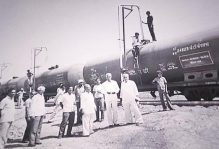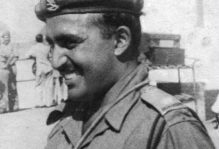Diary of an IAS Officer: “85%, Sir”
Editors Note:Mr CK Koshy(author of the article) was the additional chief secretary of Gujarat state when the Bhuj earthquake happened. He was one of the architects of the massive rescue and relief effort undertaken for the victims of one of India’s worst natural disasters. Mr Koshy in this article gives a ring side view of the situation in the aftermath of the earthquake and how the government machinery stood up to the challenge.
26th Jan, 2001 was marked on my calendar as a busy day. There were a number of programs lined up on occasion of the Republic day which I had to attend in my capacity as the Additional Chief Secretary of Gujarat. It was already 8.15 am and I was still on my breakfast table, I had to hurry. The official ceremony at the parade ground in Gandhinagar was scheduled for 9.30 am where both Chief Secretary and the Chief Minister were to be present. A civil servant knows early in his/her service that it is considered a sacrilege in the civil service to keep your bosses waiting and I had no intent of breaking the time-honoured creed. I gulped my breakfast making a mental note of time it would take my official Premier 118 NE car to reach the parade ground. Gujarat was probably the first state to discard the ultimate sign of officialdom, the white ambassador car. However for many years, the white ambassador with a red beacon continued to invoke both fear and hope in the onlooker across large swathe of the country. The new upstart, the Premier 118NE allotted to me, had a penchant for breaking down when it was most urgent to proceed. It had imbibed a thing or two about ‘red tape’, from the Additional Chief Secretaries it had ferried, including the present one.
By 8.40 am, I finished my breakfast and stood in front of the mirror to give last minute touches to the Bandhgala which saw the light of the day during ceremonial occasions. The adjustments were required to smoothen the consequences of my indulgence with food in the preceding months.
It was then that it started, the ground beneath my feet was shifting, the mirror was shaking and the furniture rumbling. While the Additional Chief Secretary stood confused, my wife shouted that it was an earthquake and we rushed out of the house. We were not hurt, only my ‘know all” ego of a civil servant was bruised.
By instinct and training a civil servant rushes into a disaster when the entire world is rushing out of it. Under my remit was the Revenue Department, disaster management was one of the functions mandated to the department. With the massive earthquake I had just experienced, I suspected this could be a long haul. I rushed straight to the parade grounds, where the polished brass and starched uniforms were ready to celebrate India’s 51st Republic Day. While the band played ‘kadam kadam baraye ja’’, there was utmost need for urgency in our steps, things had gone horribly wrong in western Gujarat, something which we were about to discover. After securing due permission from the Chief Secretary, I summoned a Deputy Collector, we reached the Control Room at the Sachivalya by 9.30 am and got it opened, the state’s response to the earthquake had started. A disaster control room is a rather spartan arrangement with maps, chairs, tables , rows of phones and provision for making tea to sustain the 24×7 operations.
Bureaucracy during our times was a bit slow in uptake of technology compared to the present generation of civil servants. The satellite phones issued to the district collectors had mostly been sitting in their offices in unopened packs. It was providence that during stock taking of disaster preparedness by the revenue department that these satellite phones were discovered and immediate orders sent for them to be made operational. Now with the DOT phone lines on the blink, the working satellite phone was god sent. I started calling the collectors on the sat-phone one by one. Initially the reports were sketchy. Some Collectors in South Gujarat were unaware of the earthquake. A few had felt the tremors but were yet to assess the damage. I felt a strange sense of disquiet when many Collectors of Kutch, Saurashtra and North Gujarat could not be contacted.
One of the first officer we could contact from the earthquake hit zone was Deputy Collector of a tehsil in Kutch. Over the static I enquired the extent of the damage to buildings in his area. The voice from the other side said “85% sir”. I repeated the question and the answer again came back “85%, Sir”. Exasperated, I shouted, “ for god’s sake I am not asking you the data of standing structures, I am asking you for an estimate of fallen buildings”. The answer came back again as “85%, Sir”. It was then I realised that all this time he was trying to tell me that 85% of the buildings had collapsed! A chill ran down my spine. The Deputy Collector sitting beside me with an ashen face and visibly shaken asked me, “Sir, how will this be managed”, I could not rustle up an answer.
As bits and pieces of information started to trickle in we spread a map of Gujarat on the table and tried to pinpoint the epicentre. It was evident that it was somewhere in Kutch. Showing remarkable alacrity, within the first few hours, the district collectors had been able to mobilise the government machinery to launch the first rescue response with whatever resources that was left intact. The entire state would remain eternally grateful to them.
To fight any calamity, whether it is war or floods, the commanding officer needs three important systems to work at peak efficiency. He/she needs a central control room to serve as the nerve centre to coordinate the relief efforts, he/she needs an efficient and dependable communications network to convey instructions to his/her field formations and get valuable feedback and he/she needs back up medical facilities to cater to the sick and wounded. Any military commander worth his/her salt will vouch for the necessity of these three systems.
In Bhuj all three had collapsed. The Collectorate, the headquarters of the district administrative machinery had been destroyed and lay in shambles. Telephone lines and mobile phones had ceased to work since most of the towers had fallen down. But tragically, the worst blow was the fact that the entire Civil Hospital at Bhuj was razed to the ground. 11 members of the medical staff and 182 patients had perished in the hospital itself.
Gujarat had never managed a disaster of this magnitude, which was getting graver by the minute as information from the districts, block and villages started to trickle in to us in the Control Room. The extent of damage and the deaths that occurred are all in public domain. 13,800 people lost their lives, 1,67,000 were injured, and over 1.2 million homes and buildings were destroyed or severely damaged.
The human tragedy was heart breaking. Children on a march to commemorate Republic Day crushed to death. Many members of one family were annihilated, leaving one or two young children as survivors. A poor widow sitting desolate outside her home which was wiped out along with her entire family.
The following weeks and months were spent at either the control room or in the field as part of the massive rescue and relief effort launched by the State and Government of India.
The state government helicopter with me and a few secretaries of the state departments on board circled the Bacchau town, trying to locate the makeshift helipad. The sight on ground was a horror scene straight out of World War II. It appeared that the city had been carpet bombed and the buildings razed to rubble. We landed in an open ground just outside the town. An eerie silence hit us once the chopper engines were switched off. Smoke rose from the destroyed building as if fire from the bombs were still smouldering. I was wondering whether the fires were accidentally started by the earthquake when I was informed that the smoke was from pyres of bodies being cremated by volunteers and relief workers. Where ever they found a corpse among the ruins, the procedure was to douse the body in kerosene or petrol and set it ablaze.
If Bacchau was blitzed, Bhuj was almost obliterated. Prof Yoshio Nishina, who was dispatched to Hiroshima by the Japanese government after the city had been stuck by the atom bomb summarized what he saw in his report to the government in five words- “completely wiped out and unspeakable.” My reaction to what I saw in Bhuj was no different.
That night I stood at the Bhuj airport as constant roar of heavy lift cargo aircrafts broke the silence of Bhuj town. More than 50 nations had pitched in with relief material during India’s moment of crisis. The aircraft tail numbers were of friendly and not so friendly countries. For that moment the diplomats had taken a back seat, this was time to help, the issues between nations was left to be thrashed out at a later date. The small Bhuj airport was handling traffic much beyond its capacity, as relief poured in. That night, with the gush of cold wind from the aircrafts taking off cooling my fevered brow, I realised how the entire humanity collaborated to defeat the earthquake. It was not only presidents or prime ministers but also valiant government officers, armed forces, NGOs, politicians and common citizens on ground, who would not allow the earthquake to win.
On my way out of the airport I saw a young Deputy Collector sitting at a desk set up just outside a hangar. He seemed all alone and entering figures in a register. I was informed that he was on duty recording the cargo brought in by the planes from all over the world. When I approached him, he stood up and managed to give a smile, though his eyes betrayed tiredness. For last three days he had been at his desk at the airport. He was managing to keep sleep away by injecting himself with some stimulant. He told me that there were no relievers as his colleagues were all busy in the field providing relief. I advised him to take care of his health to which he replied, “sir I have enough casual leave accumulated, after things normalise, I would take few days off to catch up on my sleep”. I was humbled. There were many such stories of exceptional leadership at the ground level, including a young revenue officer who rushed home to attend to the cremation of his own children and then rushed back to attend to the relief operations. There were no medals for them, but there was a pride that they did not back out when it mattered the most.
One of my most enduring memory is of Keshubhai Patel, the CM, driving up to the control room at about 2.30 am, all alone, and sitting next to a phone and contacting organisations all over the state, urging them to send food packets to the affected districts. I could see the anguish on his face as he worked the phone for several hours. There were no TV reporters, newspaper journalists or even party workers to see this elderly person working through the wee hours trying to mobilise relief. While the state bureaucracy was priming the government machinery, the political leadership was mobilising the citizens to put their best foot forward. To many of my young colleagues at the control room, it was a lesson on leadership from the CM. The general had himself worn the battle fatigues and was leading the charge on the enemy.
Gujarat earthquake reconstruction had many firsts, which have now become a standard response protocol. At that time, it was considered impractical and required the full backing of the political leadership. To the credit of the CM, a decision was taken that the entire reconstruction effort would be ‘owner driven’ and not ‘contractor driven’. This meant that the owner of each destroyed or damaged house would be responsible for its reconstruction, supported by grants from the Government. The task was not given to a contractor to build standard housing blocks. This proved to be an innovation, later praised by sociologists and public policy specialists alike. The onus on the government was to provide adequate materials and train masons almost overnight to undertake the task. This was done in a most creditable manner. This also ensured that in most cases the houses were ‘built back better’.
Several towns and cities were completely destroyed. The Government decided to rebuild them brick by brick. But using the disaster as an opportunity, the rebuilding was done by applying scientific town planning methods. Streets were widened, open spaces were carved out, land was earmarked for public amenities. This was achieved by applying the principles of land pooling to the town planning exercise. Consequently, new planned townships came up at places where there were congested towns with narrow streets and unhygienic environs. And all this was achieved with the willing participation of the citizens.
Another fall out was the economic resurgence of a backward district like Kutch. Both the State as well as the Centre announced a slew of measures, including tax incentives, to attract industries to Kutch and thus help rebuild the economy. The policy worked wonders. In a short span of about five years, Kutch District rose like a phoenix from the earthquake debris with a flourishing industrial base.
A young collector briefed me as we traversed the rubble, on the rescue and relief effort being made by the administration. I told him that the government appreciated the steps he had taken in his jurisdiction. With a faraway look in his eyes, the officer summed up the despondency around in the words of the famous poet Nida Fazli-
Apni marzi se kahan, apni safar ke hum hain
Rukh hawaaon ka jidhar ka hai, udhar ke hum hain
Pehle har cheez thi apni, magar ab lagta hai
Apne hi ghar mein, kisi doosre ghar ke hum hain
[This journey is not of our making,
We go in whichever direction the wind blows.
Before, everything felt like it was ours, but now
We feel like outsiders in our own home.]
Every fallen brick around repeated the lines behind him.
And as for my Premier 118NE, it never once failed during my field visits to the earthquake hit areas. It had learnt another lesson from its passengers who preceded me, while bureaucracy can put a red tape around about anything, but when a disaster strikes or an emergency situation crops up, it is at its efficient best.





